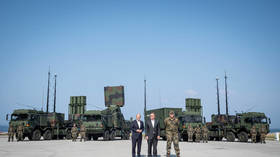Thousands of guns unaccounted for by Afghan security forces

Information on nearly three-quarters of a million guns purchased by the US for the Afghan National Security Forces is either missing or duplicated, an audit of SIGAR inspectors revealed, sparking fears they could have ended up in Taliban hands.
Both the US and Afghan authorities have failed to keep track of 747,000 weapons purchased for the Afghan National Security Forces (ANSF), the latest report from the Special Inspector General for Afghanistan Reconstruction (SIGAR) reported on Monday.
Now the US watchdog is expressing fear that at least some of these weapons could find their way into the hands of Taliban insurgents, to be used to kill ISAF and Afghan troops.
"Without confidence in the Afghan government’s ability to account for or properly dispose of these weapons, SIGAR is concerned that they could be obtained by insurgents and pose additional risks to Afghan civilians and the ANSF," said the report released on Monday.
The US Department of Defense’s OVERLORD database for Afghanistan has nearly half a million weapons registered, yet over 40 percent of the entries are either duplicated or simply missing.
Another database called SCIP, the inventory for the 700,000 weapons and auxiliary equipment (worth about $626 million) handed over by the US DoD to Afghan security forces since 2004, has also been found to be inconsistent by SIGAR investigators, who claim that tens of thousands of weapons are now unaccounted for because the data from the Department of Defense “is not very reliable.”

In 2009 a quarter of a million weapons were sent to Afghan security forces. Of these, the serial numbers of 46,000 guns were unregistered, making all of them virtually untraceable, the General Accounting office said.
“Accountability over these weapons within DOD prior to their transfer to Afghan ownership is affected by incompatible inventory systems that have missing serial numbers, inaccurate shipping and receiving dates, and duplicate records, that may result in missing weapons prior to transfer to the ANSF,” SIGAR auditors concluded.
“However, the problems are far more severe after the weapons are transferred to the ANSF. ANSF record-keeping and inventory processes are poor and, in many cases, we were unable to conduct even basic inventory testing at the ANSF facilities we visited,” the report said.
On top of it all, the Afghan National Army has been supplied with so many arms that it now has in its possession 83,184 more AK-47 assault rifles than it needs according to US estimates. But it is not just assault rifles that the Afghan Army has in plenty. Kabul also has an excessive amount of RPK machine guns (9,710 units), GP-25/30 grenade launchers (5,834), RPG-7 antitank grenade launchers (3,223) and PKM machine guns (2,443), the US News informed.

These Soviet-design weapons are enough to arm a 100,000-man army, while planned reduction of Afghan forces, due to take place after the majority of the ISAF troops leave the country by the end of 2014, suggests that even more weapons could possibly get into the wrong hands.
“Without confidence in the Afghan government’s ability to account for or properly dispose of these weapons, SIGAR is concerned that they could be obtained by insurgents and pose additional risks to Afghan civilians and the ANSF,” the report maintained, recommending to strip the Afghan government of excessive arms and make it conduct an inventory check to correctly update the database.
In an official answer to SIGAR, the US DoD stated it is already in the process of merging both databases, which implies a regular inventory check anyway. Still, the DoD claimed that it is up to the Afghan government to determine the quantity and assignment of the weapons in its possession.
“It is the Afghan government’s responsibility, not DOD’s, to determine if they have weapons in excess of their needs,” Defense officials answered SIGAR. “It is premature to speculate on potential ANSF force strength reductions. Weapons that are transferred to the ANSF become property of the Afghan government and under its control.”
But the very same report from SIGAR maintains that the situation with Afghan army arms accountability is disastrous. For example in one Afghanistan national police garrison, the only arms inventory SIGAR inspectors were provided with was an incomplete handwritten list of serial numbers. A check at Afghan Army Central Supply Depot exposed that over 10 percent of the weapons are effectively missing.
Still, in an email to Buzzfeed on Sunday, a Pentagon spokesperson, Major Bradlee Avots stressed once again that “The Afghan government is responsible for the accountability of its weapons once they are transferred to their possession, as are all receiving nations of US foreign military sales.”














